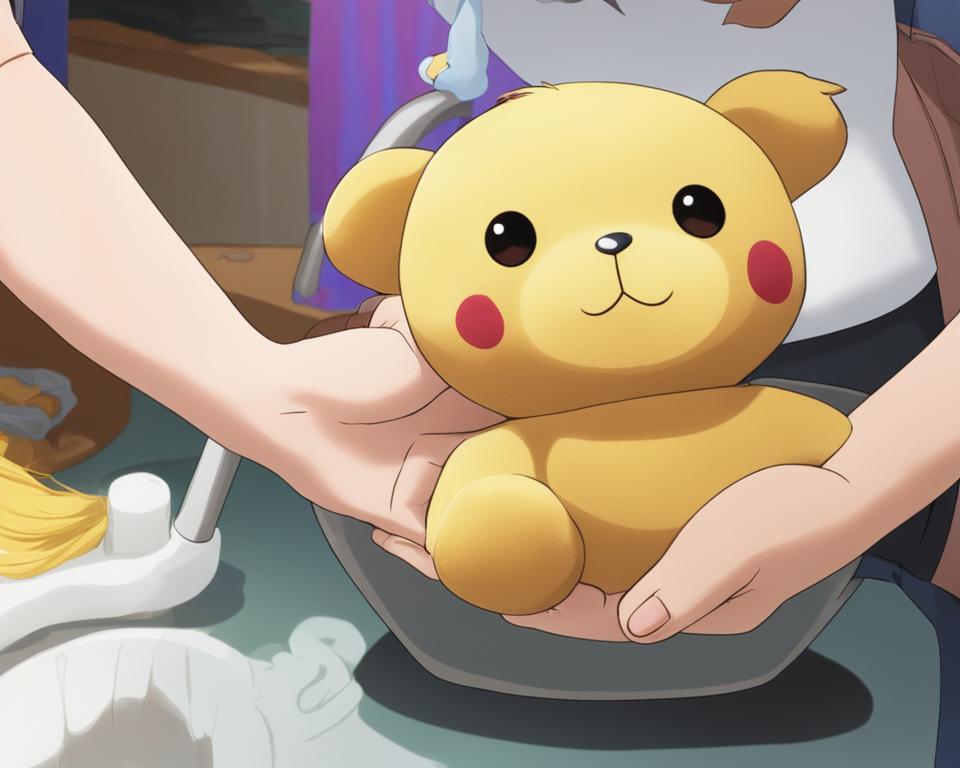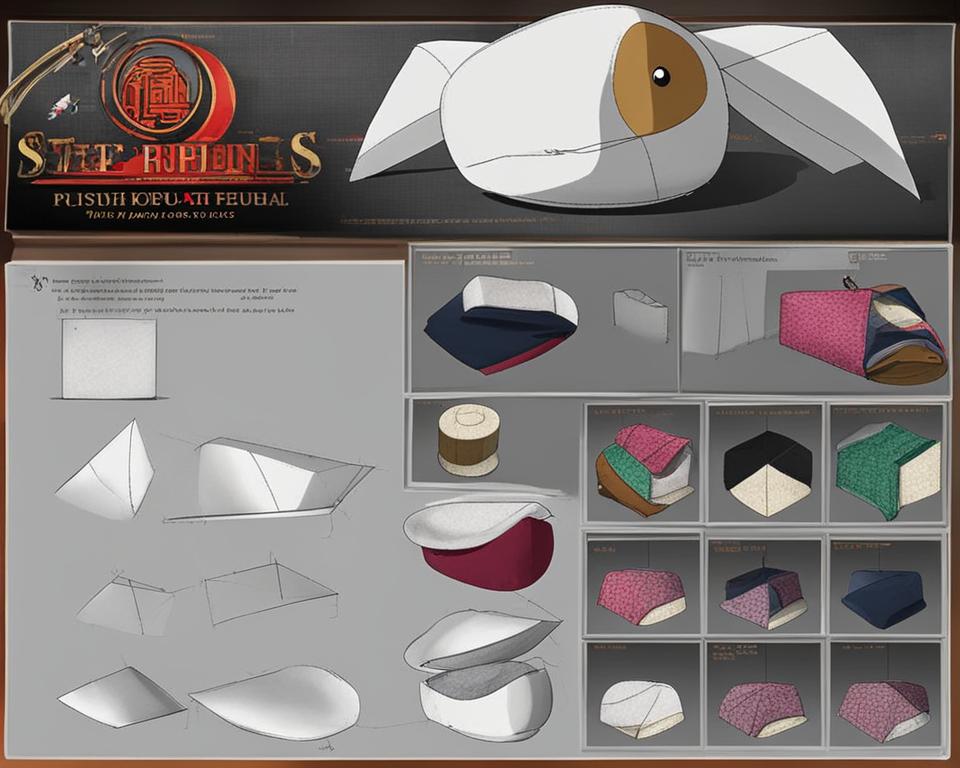Stuffed animals are cherished companions, but over time, they can accumulate dirt and stains. Cleaning them properly is essential to maintain their appearance and ensure their longevity. In this comprehensive guide, I will provide step-by-step instructions on how to clean plush toys, so you can keep them looking clean and ready for endless fun.
Key Takeaways:
- Regular cleaning is important to keep plush toys looking their best and maintain their hygienic condition.
- Choose plush toys that are age-appropriate, made from non-toxic materials, and free from small parts that can be a choking hazard.
- Surface washing with a soft cloth or gentle cleaner can effectively remove dirt and stains from plush toys.
- Machine washing may be suitable for some plush toys, but check the care tag and materials before proceeding.
- Proper drying methods, such as air drying, help prevent mildew and ensure the toy is fully dry before use.
The Importance of Cleaning Plush Toys
Plush toys are not just cuddly companions; they also play a crucial role in a child’s social and emotional development. By providing comfort, companionship, and a sense of security, these toys become an integral part of a child’s life. However, it is important to recognize the benefits of cleaning plush toys regularly.
Regular cleaning ensures that plush toys remain in optimal condition, both in terms of appearance and hygiene. Clean plush toys are essential for promoting healthy early development, including sensory and emotional growth. When children interact with clean toys, they are more likely to engage in imaginative play, building their social and cognitive skills.
Moreover, maintaining clean plush toys can contribute to a child’s overall well-being. A clean environment reduces the risk of allergies and respiratory problems, providing a safe and healthy space for children to play. By keeping plush toys clean, parents can create a nurturing environment that supports their child’s growth and development.
Choosing the Right Plush Toys
When it comes to selecting plush toys for your child, a few considerations can help ensure you make the right choice. By taking into account their age, interests, and safety, you can choose toys that provide both entertainment and educational value.
- Age appropriateness: Different plush toys are designed for different age groups. Ensure that the toy you choose is suitable for your child’s age to prevent any potential hazards.
- Safety first: Always prioritize safety when selecting plush toys. Avoid toys with small parts that could pose a choking hazard, and opt for toys made from non-toxic materials.
- Interests: Consider your child’s interests and preferences when choosing plush toys. Whether they love animals, characters from their favorite shows, or imaginative play, selecting toys that align with their interests will enhance their playtime experience.
- Care instructions: Pay attention to any care instructions provided by the manufacturer. Some plush toys may require specific cleaning methods or have restrictions on water exposure. Following these instructions will help ensure the longevity of the toy.
By considering these factors, you can choose plush toys that are not only safe but also capture your child’s imagination and provide endless hours of joy.
| Age Appropriateness | Safety | Interests | Care Instructions |
|---|---|---|---|
| Choose toys suitable for your child’s age to prevent hazards | Avoid small parts and opt for non-toxic materials | Consider your child’s interests and preferences | Follow manufacturer’s care instructions for longevity |
Surface Washing Techniques
When it comes to cleaning plush toys, surface washing is often the safest and most effective method. By following these simple techniques, you can keep your stuffed animals looking clean and fresh:
1. Gather the necessary supplies:
- A soft cloth
- Gentle cleaner specifically designed for stuffed animals
- Stiff brush
2. Dampen the soft cloth with water or apply a small amount of the gentle cleaner.
3. Gently wipe the surface of the plush toy, paying extra attention to heavily soiled areas.
4. Spot test the cleaner on a small, inconspicuous area of the toy before applying it to the entire toy.
5. Use a stiff brush to brush the fur and fluff it in all directions. This technique helps to remove dirt and restore the plush toy to its original appearance.
Remember to always check the manufacturer’s care instructions for any specific guidelines on cleaning your plush toy. Proper care ensures the longevity and cleanliness of your favorite stuffed animals.
By following these surface washing techniques, you can remove surface dirt and stains from your plush toys, keeping them looking their best and ready for playtime.
| Pros | Cons |
|---|---|
| Safe for most plush toys | May not effectively remove deep stains |
| Easy and convenient | Requires more time and effort than machine washing |
| Gentle on the fabric | Not suitable for all types of plush toys |
Surface washing is a versatile cleaning method that can be used to maintain the cleanliness of a wide variety of plush toys. However, it’s important to note that some deep stains may not be fully removed through surface washing alone.
For more stubborn stains or for plush toys that are machine washable, it may be necessary to explore alternative cleaning methods. In the next section, we will discuss the considerations and precautions for machine washing plush toys.
Machine Washing Considerations
When it comes to cleaning plush toys, machine washing can be a convenient option. However, it’s important to determine if a plush toy is machine washable before proceeding. Check the care tag and materials of the toy to ensure that it can withstand the rigors of a machine wash. Some delicate toys, those with foam fillings, or toys with internal components may not be suitable for machine washing.
To determine if a plush toy is machine washable, look for specific care instructions provided by the manufacturer. These instructions may indicate whether the toy can be machine washed, the recommended water temperature, and any precautions to take. Following these instructions will help prevent damage to the toy and ensure effective cleaning.
If the plush toy is deemed machine washable, take precautions to protect it during the washing process. Place the toy in a delicates bag or pillowcase before adding it to the washing machine. This will help prevent any small parts from becoming detached or tangled. Additionally, use a gentle cycle and mild detergent to minimize the potential for damage or discoloration. Once the wash cycle is complete, thoroughly inspect the toy for any signs of damage. If necessary, air dry or use other appropriate drying methods to ensure the toy is completely dry before use.
Summary:
Machine washing can be a convenient way to clean plush toys, but it’s crucial to determine if the toy is machine washable first. Check the care tag and materials, and follow any specific instructions provided by the manufacturer. Take precautions to protect the toy during the washing process, such as using a delicates bag or pillowcase. Use a gentle cycle and mild detergent, and thoroughly inspect the toy for any damage after washing. Proper machine washing will help keep your plush toys clean and ready for playtime.
Drying Methods for Plush Toys
After washing plush toys, it’s important to ensure they are properly dried to avoid the growth of mildew. There are various methods you can use to dry your stuffed animals, depending on your preferences and the toy’s material. Here are some effective drying methods for plush toys:
- Air drying: Air drying is the safest and most commonly used method for drying plush toys. Simply hang the toy in a warm, dry space, such as a clothesline or a hanger. Make sure to place a towel or a container underneath the toy to catch any excess water that may drip.
- Dehumidifier: If you need to speed up the drying process, you can place the plush toy near a dehumidifier. The dehumidifier will help remove moisture from the air and expedite the drying time.
- Blow dryer: If you’re in a hurry, you can use a blow dryer on a low heat or cool setting to dry the plush toy. Keep the blow dryer at a safe distance to prevent overheating or damaging the toy’s fur or fabric.
It’s important to note that you should avoid tumble drying plush toys, as the heat and agitation can cause damage. Additionally, make sure the toy is completely dry before allowing children to play with it to prevent any discomfort or potential health risks.
Tips for Avoiding Mildew in Plush Toys
Proper drying techniques can help prevent the growth of mildew in plush toys. Here are some additional tips to ensure your toys stay mildew-free:
- Always wash the plush toy according to the care instructions provided by the manufacturer.
- Prioritize air drying over other methods to allow for thorough drying and air circulation.
- Ensure that the toy is completely dry before storing it in an airtight container or bag.
- Regularly inspect the toy for any signs of mold or mildew and address the issue promptly if detected.
By following these drying methods and tips, you can effectively dry plush toys and keep them fresh, clean, and free from mildew.
Maintenance Tips for Plush Toys
Maintaining plush toys is essential to keep them clean and in good condition, ensuring they provide long-lasting joy to children. By following these simple maintenance tips, you can extend the lifespan of your plush toys and keep them looking their best.
Using a Lint Roller on Stuffed Animals
A lint roller is a handy tool for quickly removing dust, hair, and debris from the surface of plush toys. Roll the lint roller gently over the toy, paying extra attention to areas where dust and hair tend to accumulate, such as the fur or crevices. The sticky surface of the lint roller will effectively lift away any unwanted particles, leaving the toy looking fresh and clean.
Spot Cleaning Techniques
Spot cleaning is a useful technique for addressing stains and spills on plush toys, especially those that are not machine washable or have delicate materials. Start by blotting the stain using a clean cloth or paper towel to remove any excess liquid. Then, mix a mild detergent with warm water and gently dab it onto the stain using a sponge or cloth. Avoid rubbing the stain, as this can spread it further. Finally, rinse the area with clean water and allow it to air dry. This spot cleaning method is effective for maintaining the cleanliness of plush toys without risking damage.
Regular Washing Schedule
In addition to spot cleaning, it’s important to establish a regular washing schedule for plush toys. Check the care instructions provided by the manufacturer to determine if the toy is machine washable. If it is, place the toy in a delicates bag or pillowcase to protect it during the washing process. Use a gentle cycle and mild detergent to avoid damaging the toy. For non-machine washable toys, consider surface washing or using a fabric-safe disinfectant spray to keep them clean and fresh. By incorporating regular washing into your plush toy maintenance routine, you can ensure their hygienic condition and prolong their lifespan.

Proper maintenance is key to preserving the appearance and longevity of plush toys. By using a lint roller to remove dust, employing spot cleaning techniques to tackle stains, and establishing a regular washing schedule, you can keep your plush toys in optimal condition. Remember to always check the care instructions and spot test any cleaning products before applying them to your toys. With these maintenance tips, your plush toys will continue to bring joy and comfort for years to come.
Conclusion
Proper plush toy maintenance is essential for their long-lasting enjoyment and cleanliness. By following the recommended cleaning techniques and regular maintenance practices, you can ensure that your plush toys remain in excellent condition for years to come.
Regular surface washing or machine washing, coupled with appropriate drying methods, will keep your plush toys fresh and ready for playtime. Remember to check the care instructions and materials of each toy before washing it to avoid any damage or loss of shape.
In addition to washing, regular maintenance is crucial. Use a lint roller or tape to remove dust and debris from the surface of the toys, and spot clean any stains using a mild detergent or stain remover. These simple steps will help keep your plush toys looking their best and extend their lifespan.
With the right care and attention, your plush toys can continue to bring joy and comfort to children’s lives. Invest a little time in their maintenance, and you’ll enjoy long-lasting fun with your cherished companions.
FAQ
Can all plush toys be machine washed?
Not all plush toys are suitable for machine washing. Check the care tag and materials of the toy to determine if it can be safely machine washed. Avoid machine washing plush toys with delicate materials, foam fillings, or internal components.
How do I dry plush toys after washing?
Air drying is the safest option for drying plush toys. Hang the toy in a warm, dry space. Alternatively, placing the toy near a dehumidifier or using a blow dryer on a low heat setting can expedite the drying process. Avoid tumble drying plush toys.
How do I maintain plush toys?
Use a lint roller or tape to remove dust and debris from the surface of the toys. Spot clean any stains using a mild detergent or stain remover. For non-washable or delicate toys, spot cleaning is the best option to maintain their cleanliness.
Can I use any cleaner to surface wash plush toys?
It is recommended to use a gentle cleaner specifically designed for stuffed animals or a soft cloth dampened with water. Spot test any cleaner before applying it to the entire toy to ensure it does not cause damage.
How do I choose the right plush toys for my child?
When selecting plush toys, consider your child’s age, interests, and safety. Choose toys that are age-appropriate, free from small parts that can be a choking hazard, and made from non-toxic materials. Follow any specific care instructions provided by the manufacturer.





